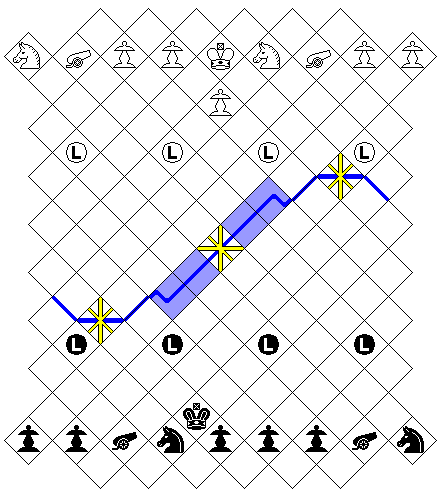
This interesting game is described in a book dated 1866. Its inventor was Colonel Charles B. Richardson. While the title of the book on the cover is simply "War-Chess", the running title on the tops of the pages is "War-Chess; or the Game of Battle", and, thus, this game may also be known as The Game of Battle.

The pieces in this game are:
Cavalry, represented by Knights, moves up to three spaces in any orthogonal or diagonal direction.
Light Infantry, represented by a circle with the letter L, moves up to two spaces in any diagonal direction, and up to three spaces in any orthogonal direction.
Infantry of the Line, represented by Pawns, moves up to two spaces in any orthogonal or diagonal direction.
Artillery, represented by Cannons, moves diagonally only, up to three spaces.
The Wagon, represented by the White King, moves diagonally only, up to two spaces.
The Citadel, represented by the Black King, cannot move.
Cavalry, Light Infantry, and Infantry of the Line capture normally, as in Chess.
Artillery pieces can only capture other Artillery pieces normally. However, when an Artillery piece is situated so that it could otherwise move to a square occupied by a piece that it cannot capture, that piece is said to be checked, and the opponent to which it belongs must then do one of three things on the next turn:
Neither the Wagon nor the Citadel can capture.
The object of the game is to capture the opponent's Wagon or Citadel. If all the opponent's pieces other than the Wagon or the Citadel and the opponent's Artillery pieces are captured, that is also a way to win, because it makes the opponent unable to win, due to the limitations on capture by Artillery.
The board is divided by a river, which can only be crossed in three places. In the middle of the board is a Bridge, which can be crossed in one orthogonal direction and two diagonal directions, indicated by yellow lines, and on the edges of the board, there are two Fords, each of which may be crossed in one diagonal direction and two orthogonal directions.
Thus, the thick blue line representing the river cannot be crossed, and the light blue squares within which the river runs down the middle cannot be entered or crossed.
Just as pieces cannot move across the river except where the Bridge or the Fords allow, also Artillery cannot give check, or pieces make capturing moves, across the river; but they can do this across the Bridge or the Fords in the permitted directions.
It is not explicitly stated what happens if a player cannot rescue a piece that is checked by Artillery. There are several possibilities:
Since the unusual capture and check properties of the Artillery piece strongly determine the character of this game, as the ability of the Artillery to make a threat that must be answered to the pieces it cannot capture, instead of merely making captures that could be allowed in order to safeguard something else more valuable, it is regrettable that this is not explicitly described in the rules.
It is noted explicitly in an example that if an Artillery piece is pinned because if it were moved, it would be exposing another piece to check from enemy Artillery, then that piece does not give check on a square to which it cannot currently actually move because of the pin.
White is referred to as the attacking player, while Black is referred to as the defending player. While this is not stated explicitly, it seems reasonable to assume that White moves first.
Given that White moves first, and the White King, the Wagon, can move, while the Black King, the Citadel, cannot, it appears that White has a significant advantage.
However, crossing the river in order to attack the opponent places one at a disadvantage. Since the Citadel cannot move, White must cross the river in order to win, while Black might expect that as White mounts an attack, Black would eventually move the Wagon across the river in order not to leave it undefended. Thus, at least unless Black decides to wait for White to come to him, despite this fact, it could be that Black's weakness can actually be a source of strength.
Possibly, however, a rule does need to be added to the game in order to require White to adopt an attacking strategy, in order for the game to be genuinely playable and balanced. However, it may also be that draws are counted as victories for the defending player, in which case it would be the defending player that has the advantage.